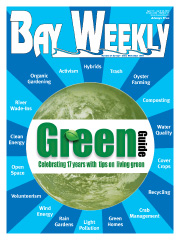Chesapeake Bay's Independent Newspaper ~ Since 1993
1629 Forest Drive, Annapolis, MD 21403 ~ 410-626-9888
Volume xviii, Issue 16 ~ Apri 22 to April 28, 2010
Home \\ Correspondence \\ from the Editor \\ Submit a Letter \\ Classifieds \\ Contact Us
Best of the Bay \\ Dining Guide \\ Home & Garden Guide \\ Archives \\ Distribution \\ Advertising![]()


Bay Gardener |
Don’t Be Sold a Bill of Goods
Weed-and-feed fertilizers are bad for the Bay — and for your lawn and wallet
Do the Bay an Earth Day favor and swear off weed-and-feed fertilizers. If I had my way, they’d be outlawed. I am willing to bet that they contribute significantly to pollution of the Bay. Both nutrients not absorbed by the roots and weed killers added to the fertilizers enter the Bay as non-point-source pollution. As does the weed-and-feed fertilizer that falls on sidewalks, driveways and the edges of roads.
Spring is not even the proper time of year to fertilize your lawn. Cool-season grasses such as bluegrass and fescue produce most of their roots and absorb most of their nutrient needs when soils are cooling in late summer and early fall and the growth of grass blades slows down. These grasses should be fertilized in late summer, from the end of August through September. Perennial grasses like bluegrass and fescue do not grow roots while growing grass. In other words, the roots of these grasses grow and store nutrients while the soils are cool and the tops are not growing. During the spring and summer months, the grass grows.
Lawn weeds are best killed in the spring, and that’s when weed killers should be applied. However, for the weed killers to work, the weeds must be growing vigorously and the lawn must be wet when they are applied. Weed-and-feed fertilizers are useless for killing wild garlic because the granules will not stick to its vertical stems.
Use weed-and-feed fertilizers in the spring and you’ll be hurting your lawn as well as wasting money and hurting the Bay. Weed-and-feed contributes to lawn-disease problems such as verticilium wilt. This is especially true if the lawn was fertilized in early fall as recommended. The additional nitrogen applied with the weed-and-feed make the grass too succulent, thus opening the door to invasion by diseases.
Learn to control lawn weeds by raising your mowing height to three and a half to four inches, maintaining the soil pH between 6.0 and 6.8, mowing at least weekly and allowing the clippings to remain in place to decompose and let the grass recover those nutrients.
The simple spring solution to a good yard is cut it tall and let if fall.
Will Cambistat make a tree grow?
Q The city of Annapolis requests that we treat an old white oak with Cambistat to encourage growth. The tree sits close to a new home. Soil compaction on the one side from foot traffic makes me think that it would benefit more from vertical mulching. The tree sits on the edge of a slope, and 50 percent of its roots are on the downhill side where compaction has taken place.
How do you feel about Cambistat, a growth hormone according to the manufacturer?
Thanks as always for your insight.
–Heike Nolker, Landscape Architect
A There is no substitution in solving soil compaction other than improving the soil. Cambistat is a waste of time and money; I have yet to see any published data supporting its use. I agree with you that vertical mulching is the answer.
Ask Dr. Gouin your questions at [email protected]. All questions will appear in Bay Weekly. Please include your name and address.
© COPYRIGHT 2010 by New Bay Enterprises, Inc. All rights reserved.
